
Beetles are insects that form the order Coleoptera, in the superorder Endopterygota. Their front pair of wings are hardened into wing-cases, elytra, distinguishing them from most other insects. The Coleoptera, with about 400,000 described species, is the largest of all orders, constituting almost 40% of described insects and 25% of all known animal life-forms; new species are discovered frequently, with estimates suggesting that there are between 0.9 to 2.1 million total species. Found in almost every habitat except the sea and the polar regions, they interact with their ecosystems in several ways: beetles often feed on plants and fungi, break down animal and plant debris, and eat other invertebrates. Some species are serious agricultural pests, such as the Colorado potato beetle, while others such as Coccinellidae eat aphids, scale insects, thrips, and other plant-sucking insects that damage crops.

Helicoverpa zea, commonly known as the corn earworm, is a species in the family Noctuidae. The larva of the moth Helicoverpa zea is a major agricultural pest. Since it is polyphagous during the larval stage, the species has been given many different common names, including the cotton bollworm and the tomato fruitworm. It also consumes a wide variety of other crops.

Pest control is the regulation or management of a species defined as a pest, a member of the animal kingdom that impacts adversely on human activities. The human response depends on the importance of the damage done and will range from tolerance, through deterrence and management, to attempts to completely eradicate the pest. Pest control measures may be performed as part of an integrated pest management strategy.

Dermestidae are a family of Coleoptera that are commonly referred to as skin beetles. Other common names include larder beetle, hide or leather beetles, carpet beetles, and khapra beetles. There are approximately 500 to 700 species worldwide. They can range in size from 1 to 12 mm. Key characteristics for adults are round oval shaped bodies covered in scales or setae. The usually clubbed antennae fit into deep grooves. The hind femora also fit into recesses of the coxa. Larvae are scarabaeiform and also have setae.
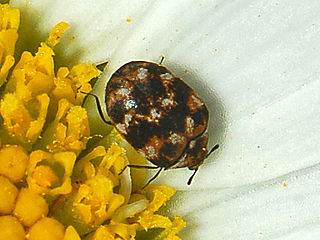
The varied carpet beetle is a 3 mm-long beetle belonging to the family Dermestidae. They are a common species, often considered a pest of domestic houses and, particularly, natural history museums, where the larvae may damage natural fibers and can damage carpets, furniture, clothing, and insect collections. A. verbasci was also the first insect to be shown to have an annual behavioral rhythm and to date remains a classic example of circannual cycles in animals.

The light brown apple moth is a leafroller moth belonging to the lepidopteran family Tortricidae.
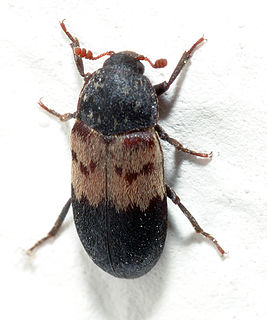
Dermestes is a genus of beetles in the family Dermestidae, the skin beetles. The genus is distributed worldwide.

Agrotis ipsilon, the dark sword-grass, black cutworm, greasy cutworm, floodplain cutworm or ipsilon dart, is a small noctuid moth found worldwide. The moth gets its scientific name from black markings on its forewings shaped like the letter "Y" or the Greek letter upsilon. The larvae are known as "cutworms" because they cut plants and other crops. The larvae are serious agricultural pests and feed on nearly all varieties of vegetables and many important grains.
Home-stored product entomology is the study of insects which infest foodstuffs stored in the home. It deals with the prevention, detection and eradication of the pests. The five major categories of insects considered in this article are flour beetles, the drugstore beetle, the sawtoothed grain beetle, the Indianmeal moth and fruit flies.
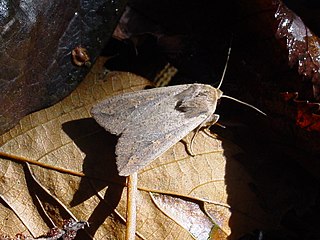
Mythimna unipuncta, the true armyworm moth, white-speck moth, common armyworm or rice armyworm, is a nocturnal agricultural pest belonging to the family Noctuidae. This moth is also commonly referred to by the scientific name Pseudaletia unipuncta. The species was first described by Adrian Hardy Haworth in 1809. Mythimna unipuncta is found in the Americas and in parts of Europe, Africa and Asia. Its original distribution is North and South America. It has been introduced to other places from there. They are known as armyworms because the caterpillars move in lines as a massive group, like an army, from field to field, damaging crops.
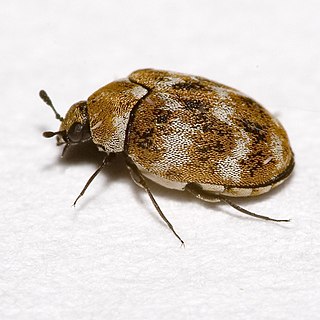
Anthrenus is a genus of beetles in the family Dermestidae, the skin beetles. One of several genera of carpet beetles, Anthrenus was historically placed in a subfamily Anthreninae, though presently included in the Megatominae. The genus Neoanthrenus is closely related.
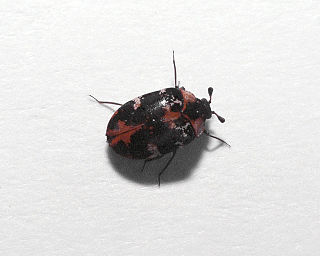
Anthrenus (Anthrenus) scrophulariae, also known as the common carpet beetle or buffalo carpet beetle, is a species of beetle originally found in Europe, the Middle East and the Nearctic, which has now spread to most of the world. Adult beetles feed on pollen and nectar, but the larvae feed on animal fibres and can be damaging pests to carpets, fabrics and museum specimens.

Cadra calidella, the dried fruit or date moth, is a species of snout moth in the genus Cadra and commonly mistaken for the species Cadra figulilella. It thrives in warmer conditions and is found primarily in Mediterranean countries, although it can also be found in Central Asia, Kazakhstan, Transcaucasia, Caucasus, and the western part of Russia. It feeds on dried fruits, carobs, nuts and seeds, hence earning its colloquial name. This diet damages the food industry, and it is a common storage pest. Because of this, much research has been done to study ways to limit its reproduction rate and population size. It was first described by Achille Guenée in 1845.

Thylodrias is a monotypic genus of beetles in the family Dermestidae containing the single species Thylodrias contractus, known commonly as the odd beetle and tissue paper beetle. It is native to Asia and is a widespread introduced species in North America. It can be a pest at times.

Anthrenocerus australis is a species of beetle belonging to the Dermestidae family. It is commonly known as the Australian carpet beetle and is one of the most researched of the thirty-one species in the Anthrenocerus genus. This is generally attributed to its prevalence throughout Australia and New Zealand and the negative economic and agricultural impact it has as a pest. It is the larvae that causes damage to products, not the adult beetle. The total life cycle of this insect is around three years, most of which is spent as a larva. Once the beetle reaches maturity, it only lives for between two and six weeks.

Diabrotica balteata is a species of cucumber beetle in the family Chrysomelidae known commonly as the banded cucumber beetle. It occurs in the Americas, where its distribution extends from the United States to Colombia and Venezuela in South America. It is also present in Cuba. It is a pest of a variety of agricultural crops.
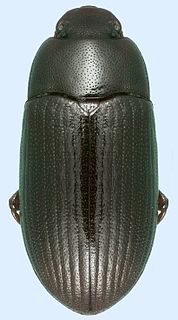
Alphitobius diaperinus is a species of beetle in the family Tenebrionidae, the darkling beetles. It is known commonly as the lesser mealworm and the litter beetle. It has a cosmopolitan distribution, occurring nearly worldwide. It is known widely as a pest insect of stored food grain products such as flour, and of poultry-rearing facilities. It is a vector of many kinds of animal pathogens.
Integrated pest management in museums, libraries, archives and private collections is the practice of monitoring and managing pest and environmental information with pest control methods to prevent pest damage to collections and cultural property. Preserving cultural property is the ultimate goal for these institutions. The pests come in many different forms: insects, mites, rodents, bats, birds, and fungi and the two most common types are insects and fungi. It is widely recommended that every museum have some form of pest control in place and monitoring system to protect their collection and that museums review their storage and museum facilities to determine how to best control and prevent pest infestations while utilizing an Integrated Pest Management plan.

Dermestes ater is a species of beetle in the family Dermestidae, the skin beetles. It is known commonly as the black larder beetle or incinerator beetle. It is native to North America, but today it is found nearly worldwide. Like several other dermestid beetles, this species is a common pest of stored products.
Anthrenus sarnicus, the Guernsey carpet beetle, is a type of carpet beetle. It can be generally found in Great Britain. Its suborder is Polyphaga, the infraorder is Bostrichiformia, the superfamily is Bostrichoidea, and the family is Dermestidae. The carpet beetle is shaped like an oval and about the size of a pin.



















